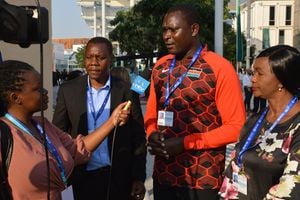Kirinyaga battling invasive snail from South America brought by climate crisis: Waiguru

Kirinyaga Governor and chairperson of Council of Governors (CoG) Anne Waiguru during a panel discussion on thedomestication of Climate Action for transboundary and Ecosystem at KenyaPavillion at COP28 in Dubai, United Arab Emirates on December 6, 2023.
What you need to know:
- According to America’s Centers for Disease Control and Prevention (CDC), various parasites can cause meningitis or can affect the brain or nervous system.
- CDC also notes that parasitic meningitis is much less common than viral and bacterial meningitis.
Kirinyaga County is currently grappling with a new unwanted guest that has found its way into the country from South America due to climate change, Council of Governors (CoG)chair Anne Waiguru says. Earlier this year, Nation had reported that scientists at the Kenya Medical Research Institute (Kemri) had found an invasive freshwater snail that originates from South America in the Mwea Irrigation Scheme.
Kemri said that the water snail, known scientifically as Pomacea canaliculata (P. canaliculata), is currently wreaking havoc in rice farms and is moving along the Nile. It is known to cause human eosinophilic meningitis.
According to the Nature journal, the Pomacea species, commonly known as apple snails, are native to South America and have become widely distributed agricultural and environmental pests in southern China since their introduction in the 1980s.
“The climate crisis has fuelled the spread of waterborne diseases (like) malaria and gastropod mollusks such as the new invasive water snail that has found a home in Kirinyaga County all the way from South America, thus causing major public health concerns,” said Ms Waiguru.
According to America’s Centers for Disease Control and Prevention (CDC), various parasites can cause meningitis or can affect the brain or nervous system. CDC also notes that parasitic meningitis is much less common than viral and bacterial meningitis.
“Some parasites can cause a rare form of meningitis called eosinophilic meningitis, eosinophilic meningoencephalitis, or EM. The three main parasites that cause EM in some infected people are Angiostrongylus cantonensis (neurologic angiostrongyliasis), Baylisascaris procyonis (baylisascariasis; neural larva migrans) and Gnathostoma spinigerum (neurognathostomiasis).”
In an interview with Nation, Dr Martin Mutuku, the principal investigator and a senior research scientist at the Centre for Biotechnology Research and Development at Kemri, explained that the snail is considered a devastating agricultural and ecological pest as well as a threat to rice farming in Mwea and wetlands biodiversity in the country apart from being a potential public health threat.
“The million-dollar question is: how did the snail exactly get here? Farmers told us that it feeds on young rice seedlings during the planting season. It causes meningitis in humans when it gets to the brain as the parasite gets lost in there,” he explained. “We have to also strengthen collaboration among the sectors responsible in managing the ecosystems and those benefiting from ecosystem services to create holistic and effective resilient strategies.”
While urging the East African Community (EAC) to prioritise active involvement of local and sub-national governments as primary actors in adaptation planning, Governor Waiguru said that her county has been working with the health ministry to tame the new unwanted guest.
“For us to be resilient, we must remember that nature does not respect man-made boundaries of nations and ensure that development of strategies and planning goes from the top all the way to subnational levels,” she told delegates while noting that the EAC bloc is home to diverse and interconnected ecosystems such as forests, mountains, wetlands, rivers and lakes.
“These ecosystems play a vital role in maintaining biodiversity, regulating climate patterns, supporting local communities’ livelihoods, and providing essential services such as water supply, food security, and carbon sequestration. However, these ecosystems face significant threats from climate change, affecting their resilience and functionality,” said Governor Waiguru.
As researchers sought to unearth how the snail reached there, sampling was done using a standard snail scoop in 15 streams, four ponds and four canals within the Mwea Irrigation Scheme.
The snails and snail egg masses collected were transferred into plastic containers and identified using snail taxonomic keys based on morphological features with the aid of a dissecting microscope.
“The presence of a thriving population of P. canaliculata in the Mwea irrigation canals, ponds and rice paddies was confirmed, and numerous pomacea egg masses also observed,” findings from the Kemri study done in Kirinyaga show.
According to the findings, P. canaliculata serves as an intermediate host of the rat lungworm, Angiostrongylus cantonensis, which causes human eosinophilic meningitis, an emerging disease.
“The team of researchers also interestingly found that another snail that exists in the country which causes bilharzia has drastically reduced in number due to the arrival of the new snail.
“Only two canals located on the upper periphery side of the irrigation scheme were found to be having Biomphalaria pfeifferi snails. Most likely, they may be competing for resources. We are still investigating,” Dr Mutuku told Healthy Nation.





